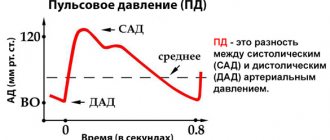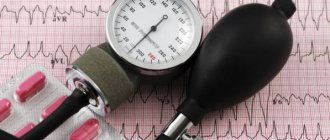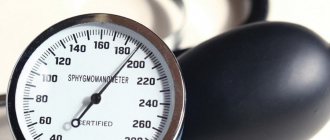The secret of longevity is in blood vessels
If they are clean and healthy, then you can easily live 120 years or even more
To learn more…
It is possible to understand how the body functions, as well as various organs, through pressure measurements and the data obtained. The information during the measurement speaks about the speed of blood flow and the force of its ejection, due to this a person may feel differently. There is a norm and its boundaries, because throughout the day, pressure fluctuates for various reasons, but when the levels go beyond the norm, pathological changes in the body are possible. It is important to understand what upper and lower pressure mean, what danger is behind the indicators, and what the norms are.
What is blood pressure?
Arterial pressure
- Blood pressure is the natural process of blood pressure on the walls of blood vessels, capillaries, veins and arteries. If a person is completely healthy, then he generally does not notice how the blood circulates inside his body. But if something is wrong with the body, then depending on whether it is high or low, a person may feel a headache, pulsation in the back of the head, nausea and dizziness.
- Now let's figure out why this happens. If you were a diligent student at school, then you probably remember that the blood in the human body is always in motion. Even when a person is resting, it continues to circulate through his arteries and veins. As soon as it reaches the ventricles of the heart, a spasm of the heart muscle occurs and blood under pressure is released into the vessels and begins to fill them quite quickly, putting pressure on their walls. If at this stage there is more or less pressure on the vessels than necessary, then the person begins to feel all those unpleasant symptoms that we introduced you to above.
- From all this we can draw only one conclusion: our blood pressure directly depends on how often and with what force the heart muscle contracts. Therefore, if you notice a deviation in one direction or another, then be sure to check if you have heart problems. If the examination shows that it is working correctly, begin to look for other reasons for the malfunction of the vascular system.
Interpretation of pressure readings on a tonometer
To correctly decipher measurement readings, you first need to understand what the generally accepted and individual norm is. There are average standards, but it is best to focus not on them, but on your “working” pressure. It can be determined by monitoring numbers that show pressure for several days twice a day - an hour after waking up in the morning and in the evening.
Normal indicators
The concept of normal when measuring blood pressure is relative, since the result is influenced by many factors: the time when the measurement is made; psychological state of a person; taking medications or stimulants; physical activity and more. However, during medical research, optimal standards were determined. They depend on gender, age and genetic predisposition. Average pressure indicators depending on gender and age are shown in the table:
| Age, years | Systolic, mm Hg Art. | Diastolic, mm Hg Art. | ||
| Men | Women | Men | Women | |
| 17—20 | 123 | 116 | 76 | 72 |
| 20—30 | 126 | 120 | 79 | 75 |
| 30—40 | 129 | 127 | 81 | 80 |
| 40—50 | 135 | 135 | 83 | 84 |
| 50—60 | 135 | 135 | 85 | 85 |
| over 60 | 135 | 135 | 89 | 89 |
A slight decrease or increase in blood pressure, which is shown in the table, is also considered normal:
| Normal reduced | Normal | Normal elevated |
| 100—110/60—70 | 120—130/70—85 | 130—139/85—89 |
Do not forget that as a person ages, blood pressure physiologically becomes higher. Therefore, for people over 70 years of age, 140/90 mmHg readings on a tonometer will be considered normal. Art.
Deviations
Top indicators
High blood pressure, characterized by numbers above 140/90 mmHg. Art., which is displayed by a tonometer, is called hypertension. Arterial hypertension has three stages. The designations are described in the table:
| Stage | Blood pressure, mmHg Art. | |
| Systolic | Diastolic | |
| 1st (easy) | 140—159 | 90—99 |
| 2nd (medium) | 160—179 | 100—109 |
| 3rd (heavy) | above 180 | above 110 |
The first stage is considered harmless and does not require drug treatment. As a rule, it is enough to give up bad habits, adhere to a certain diet and avoid stressful situations in order to stabilize the condition. At the second stage, it is necessary to take hypertensive drugs, the list of which is determined only by the attending physician. The third stage requires hospitalization, as it is dangerous due to complications such as hypertensive crisis.
Systolic pressure: what is it and what is it responsible for?
Systolic pressure
- Systolic pressure (we call it upper) is the maximum blood pressure at the moment when the heart muscle pushes blood out of the heart. This indicator helps us find out how fast our heart beats. If everything is in order with him, then the upper indicators will not exceed 110-130 units. Yes, and remember, such blood pressure levels can only be found in healthy people whose cardiovascular system works like a clock. But the older a person gets, the higher his blood pressure will rise; for example, for 55-year-old men and women, 140 units is considered normal.
- Systolic blood pressure is responsible for the proper functioning of the heart and blood vessels, so if something starts to happen to them, its indicators begin to deviate noticeably from the norm. If the blood becomes viscous or cholesterol plaques greatly narrow the blood flow, then its levels begin to rise above normal. If a person has intoxication of the body or is very tired, blood pressure readings may drop below normal.
- But no matter which direction the systolic pressure readings fall, always remember that the most minimal deviation from normal physiological readings will sooner or later lead to not entirely pleasant consequences. If you do not try to establish the correct functioning of the cardiovascular system, then first this pathological process will begin to destroy the smallest vessels, and then move on to larger ones. As soon as they are destroyed, blood circulation in the body is completely disrupted, and this is already fraught with the development of hypertension.
Upper blood pressure
Systolic is the pressure experienced by the vascular walls at the time of systole (contraction of the heart muscle). Blood pressure is written as a fraction, and the number on top indicates the systolic level, which is why it is called upper. What does its size depend on? Most often from the following factors:
- contraction forces of the heart muscle;
- tone of blood vessels, and therefore their resistance;
- number of heart contractions per unit time.
The ideal upper blood pressure is 120 mm Hg. pillar Normal ranges from 110 to 120. If it is more than 120 but less than 140, it is said to be prehypotension. If blood pressure is 140 mmHg or higher, it is considered elevated. The diagnosis of “arterial hypertension” is made if a persistent excess of the norm is observed over a long period of time. Isolated cases of increased blood pressure are not hypertension.
Blood pressure can change constantly throughout the day. This is due to physical activity and psycho-emotional stress.
Causes of increased upper blood pressure
Systolic blood pressure may increase in healthy people. This happens for the following reasons:
- under stress;
- during physical activity;
- after drinking alcohol;
- when eating salty foods, strong tea, coffee.
Pathological reasons for the increase include the following:
- renal pathologies;
- obesity;
- disorders of the adrenal glands and thyroid gland;
- vascular atherosclerosis;
- disturbances in the functioning of the aortic valve.
Symptoms of elevated systolic blood pressure
If the upper pressure is elevated, there may be no symptoms, but with prolonged and persistent hypertension the following symptoms appear:
- headache, usually in the back of the head;
- dizziness;
- labored breathing;
- nausea;
- flickering of flies before the eyes.
Causes of low systolic blood pressure
It may temporarily decrease in the following cases:
- when tired;
- climate and weather changes;
- in the first trimester of pregnancy;
- during physical activity.
This condition is not a deviation from the norm and quickly returns to normal without any intervention.
Low systolic blood pressure is characterized by increased drowsiness and lethargy
Treatment is required if low blood pressure is a symptom of diseases, such as:
- disturbances in the functioning of the heart valve;
- bradycardia (decreased heart rate);
- intoxication;
- diabetes;
- brain injuries.
Symptoms of low systolic blood pressure
If the upper pressure is low, a person experiences:
- prostration;
- drowsiness;
- irritability;
- apathy;
- sweating;
- memory impairment.
Diastolic pressure: what is it and what is it responsible for?
Diastolic pressure
- Diastolic blood pressure (we call it lower) is the force of blood pressure on the walls of the arteries at the moment when the heart muscle completely relaxes after contracting. In addition, this indicator helps us find out with what force blood circulates through our veins and arteries. In a completely healthy person, this figure can range from 65 to 80 units. Such a large difference in indicators is due to the general condition of the body. If its vessels are sufficiently elastic and have good tone, then, as a rule, diastolic pressure indicators remain at around 75-80 units.
- If the vessels are damaged, the blood flow is disrupted and the indicators begin to jump in one direction or another. Also, blood pressure indicators are greatly influenced by the frequency of contraction of the heart muscle and the amount of blood that the heart pumps. But even if you notice that your diastolic pressure has begun to drop or rise significantly, there is no need to sound the alarm right away. This indicator can be affected by stress, nervous disorders, hypothermia and even sudden temperature changes. Therefore, if they deviate from the norm by literally a few units, then just try to get more rest.
- If you see that your blood pressure readings have jumped or dropped by 10-15 units, then this is a reason to consult a specialist. As a rule, deviations in one direction or another occur due to the fact that the strength of the blood flow decreases or, conversely, increases. And if this process is not stabilized in the shortest possible time, then after some time the body will stop receiving the required amount of oxygen and, as a result, various health problems will begin.
Norm
Doctors note that the normal diastolic value is 60-90 mmHg. Depending on age and gender, the determined indicators may change and fall:
| Patient category | Age, in years | Diastolic pressure limits, mmHg |
| Men | 20-65 | 76-89 |
| Elderly patients | over 65 | 89 |
| Women | 20-65 | 72-89 |
| Pregnant women | After 6 months | Plus/minus 10 from normal |
| Children | 0-10 | 40-78 |
| Teenagers | 11-15 | 70-86 |
Normal difference between systolic and diastolic pressure
Normal difference between lower and upper blood pressure
- Every adult knows that blood pressure readings of 120/80 are considered ideal. If you carry out simple mathematical calculations, you can understand that normally the difference will be approximately 40 units. If the gap between systolic and diastolic pressure increases to 65 units, then a person’s likelihood of developing cardiovascular diseases increases sharply. In addition, the not entirely correct functioning of the heart and blood vessels begins to wear out the walls of veins and arteries very quickly, and this begins to provoke premature aging processes.
- If a person has health problems, the gap between the lower and upper pressure can increase to 45 or decrease to 35 units. With such indicators, the human body can also function correctly, although some people may experience excessive drowsiness. As for older people, the difference between their upper and lower blood pressure can be 50 units. This is due to the fact that natural tissue wear and tear has occurred in the body and the walls of blood vessels and arteries have become less elastic.
Permissible difference between upper and lower pressure
Permissible difference between upper and lower pressure
- As you probably already understood, the acceptable difference between the lower and upper pressure is 40 units. General practitioners call this blood pressure working and, based on deviations from this figure, they judge what is happening inside the body. And although this indicator is considered the most ideal, even among young and healthy people, at first glance, it is difficult to find a person with such pressure.
- That is why recently experts have begun to believe that the difference between upper and lower blood pressure can range from 35 to 50 units. True, in this case there is one thing, but. If the pressure difference is within normal limits, but both the upper and lower blood pressure are high, this indicates that the cardiovascular system is working very quickly, almost to the point of wear and tear.
- If both indicators, on the contrary, are too small, this indicates that the heart, cardiac muscle and blood vessels are working very slowly. Yes, and remember, in order to get the most accurate blood pressure readings, all measurements must be taken only in a relaxed state. If you do this immediately after physical activity, then the indicators will probably be higher than normal.
What is blood pressure?
Three main indicators help assess blood pressure:
- Systolic pressure is characterized by the effect of blood flow on the walls of blood vessels per second of systole.
- The diastolic value is assessed by the strength of resistance encountered by the blood at the time of diastole.
- Pulse pressure evaluates the difference between the systolic and diastolic parameters.
These indicators are not constant and can change under the influence of various factors: diseases of internal organs, heat, anxiety, excessive physical activity.
Upper
The first number obtained during measurement indicates the upper or systolic pressure. It is responsible for the frequency with which the heart muscle contracts. The process occurs with the participation of large vessels. The level of the indicator is influenced by the force with which the heart contracts, the amount of blood leaving the left ventricle, and the elasticity of the inner wall of the blood vessels. The norm for the upper parameter is in the range of 111-121 mm Hg. Art.
Hypertension is indicated by prolonged excess of values above 141 mmHg. Art. A dangerous consequence of increased systolic pressure is a hypertensive crisis. If results are obtained below 99 mm Hg. Art. hypotension is diagnosed.
When indicators shift from the norm occasionally and in certain situations (excitement, stress, tension, excessive consumption of drinks with a high caffeine content, smoking), then such cases do not relate to pathologies.
Lower
The lower blood pressure level occurs when the heart valve closes and blood does not return to the heart. At this moment, another blood enriched with nutritional components begins to flow to the heart. And there is a readiness for a new reduction. The diastolic indicator is influenced by the frequency with which the heart muscle contracts, the elasticity and surface resistance of blood vessels. Healthy indicators are considered to be 79-81 mm Hg. Art.
The big difference between upper and lower pressure: reasons, what does it mean for health?
Reasons for the large difference between upper and lower pressure
- A fairly common reason for a large difference between blood pressure readings is too low diastolic pressure readings. As a rule, these numbers are greatly influenced by the elasticity of blood vessels. If it drops, lower pressure readings also decrease. And since the substance renin, which is produced by the kidneys, is responsible for the elasticity of blood vessels, in this case, it is best to look for pathology in this organ.
- In women, similar complications can arise due to problems with the thyroid gland. If it stops producing the required amounts of hormones that the body needs for normal functioning, then absolutely all organs and systems begin to suffer because of this. Against this background, problems with the cardiovascular system may appear, which will lead to the heart and blood vessels no longer properly pumping blood and enriching internal organs with oxygen.
- Pressure indicators are also affected by age-related changes in the body. The older a person gets, the less elastic his blood vessels become. Because of this, arterial stiffness develops and the vessels can no longer cope with the pressure that the blood flow puts on them.
Systole - what does the upper indicator mean?
Systolic value is the moment of contraction of the heart muscle. The left ventricle is responsible for enriching the internal organs with blood, and the right ventricle is responsible for enriching the lungs with blood.
When measuring blood pressure, air is pumped into the cuff until the blood in the arteries stops pulsating. Then the air is released from the bulb of the manual tonometer and the heart rhythm is listened to. By the first beat you can judge the strength of the blood pressure, and the upper value is displayed on the tonometer screen.
Systole shows:
- degree of contraction of the heart muscle;
- vascular resistance;
- the number of contractile movements of the heart over a certain period of time.
The maximum rate of upper pressure is 139 units. If the systolic reading rises to 140 mm. rt. Art. regularly, doctors take the patient for examination. This is the first sign of a malfunction of the cardiovascular system. When systole decreases to 100 units, when the pulse cannot be felt manually, doctors often diagnose a disorder in the functioning of the kidneys or thyroid gland. A decrease in the upper value to 100 units is often accompanied by loss of consciousness.
Small difference between upper and lower pressure: reasons, what does it mean for health?
Reasons for the large difference between upper and lower pressure
- Blood pressure is a fairly good indicator of our health, and if pathological processes begin to occur inside the body, this immediately affects blood pressure levels. If we talk about the small difference between upper and lower pressure, then the main reason here is problems with the cardiovascular system. It’s just that in this case, problems appear that do not allow the blood flow to move through the vessels and arteries with sufficient force.
- In addition, such indicators can be provoked by a pathology such as vegetative-vascular dystonia. This disease provokes vasospasm, and as a result, blood cannot circulate properly throughout the body.
- Another reason that can provoke this behavior of blood pressure is very severe internal blood loss. In this case, instead of circulating through the veins and arteries, the blood at the site of the wound will flow into the abdominal cavity. And since the heart will not push blood into the vessels, they will completely relax and this will immediately affect the pressure readings.
- I would like to immediately say that a small difference, just like a large one, has a rather detrimental effect on the body. After all, if at first this can only affect dizziness and headache, then in the future this state of the cardiovascular system can lead to the development of tachycardia, cardiosclerosis and renal failure.
What affects blood pressure levels
Factors causing hypertension:
- overweight;
- smoking or excessive consumption of alcohol;
- insufficient physical activity;
- periodic stress, anxiety, anxiety;
- pathologies of internal organs (in particular, diseases of the urinary, endocrine, cardiac systems);
- genetic predisposition.
Symptoms of increased pressure include dizziness, pain in various areas of the head and neck, nausea and even repeated vomiting, increased sweating, weakness and fatigue, tinnitus, decreased vision, and sleep disturbances.
Doctors believe that the following unfavorable factors can cause low blood pressure:
- vegetative-vascular dystonia;
- intoxication of the body;
- exacerbation of allergies;
- a condition accompanied by large blood loss;
- poor nutrition, vitamin deficiency;
- adverse reaction caused by taking certain medications.
Hypotension can be recognized by a complex of unpleasant symptoms such as dizziness, pain in the occipital, temporal, and frontal lobes, nausea, weakness, pale skin, and impaired coordination of movements.
The difference between upper and lower pressure is 50, 60, 70, 80, 20, 40: how do you know if this is good or bad?
Difference between upper and lower pressure
- If you carefully read our article, you probably realized that the difference between the upper and lower pressure of 40 and 50 units is considered normal. Therefore, if, when measuring blood pressure, your tonometer gives, for example, 120/80 or 130/70, then you can be quite calm. In this case, the only reason to see a doctor can be regular headaches, which are accompanied by dizziness and strong pulsation in the back of the head and temples.
- But as for the difference of 70 and 80 units, in this case you should immediately seek help from a cardiologist and therapist. Such a large gap between the upper and lower pressure may indicate that the cardiovascular system is working in enhanced mode. These processes interfere with the normal functioning of the heart muscle, and this leads to the fact that the blood flow has a rather strong effect on the walls of blood vessels.
- Also a cause for concern is the very small gap between blood pressure readings (20 units). In this case, in addition to standard problems with blood vessels and the heart, kidney pathologies may be the cause of such indicators.
Little difference
Some say it is wrong to attribute a small difference if it is 30 units. The norm for a low indicator will not necessarily be 30 units or less. It is correct to carry out calculations taking into account the upper pressure indicator, and if the difference with the lower pressure is less than 25%, then this is considered a low threshold. For example, with normal upper pressure being 120 units, the difference with lower pressure should be 30 mm Hg. Art. Thus, the optimal pressure is 120 to 90 mmHg. Art. A small difference is manifested by characteristic symptoms:
- Weakness in the body.
- Irritation.
- Fainting and dizziness.
- Drowsiness.
- Inability to concentrate.
- Pain in the head.
The minimum difference should alert people, because if the number is less than 30 mm Hg. Art., the following complications may develop:
- Heart failure.
- Failure of the kidneys and other organs.
- Stroke.
- Aortic stenosis.
- Tachycardia.
- Cardiosclerosis.
- Heart attack as a result of severe stress.
A small difference can lead to hypoxia, as well as irreversible changes in the brain. Due to this, vision deteriorates, paralysis of the respiratory organs is possible, and the heart stops due to stress. As you can see, even the minimum level of deviation is very dangerous; if you do nothing, then showing pulse pressure becomes impossible to control even with medication.
The upper and lower pressure are the same: what to do?
Same levels of lower and upper blood pressure
- Indicators of upper and lower pressure may be the same if a person has some kind of cardiac pathology. After all, in order for the blood flow to circulate through our vessels, veins and arteries, it has to constantly pump and release blood. If something prevents him from doing this, the heart stops filling with blood, which leads to the fact that it contracts more than necessary.
- This condition is very dangerous for health, so if you see 110/120 or 80/70 on the tonometer, then immediately start taking action. Of course, it is best in this case to call an ambulance and get qualified help. But if you do not have the opportunity to quickly get to the hospital, then try to help yourself with the means at hand. But remember that in this case there are some nuances of pre-medical care. If the upper and lower blood pressure readings are very high, then they will need to be brought down.
- And since this will not need to be done very abruptly, it will be better if you try to normalize the functioning of the heart with the help of antagonist drugs that normalize the heart rhythm. You can also try to lower your blood pressure with diuretics. If the upper and lower pressure readings are very low, on the contrary, they will need to be raised. To do this, you can try drinking citramon and very sweet tea.
How to check?
The Korotkoff method is most often used to monitor indicators. This is a procedure for measuring blood pressure using a tonometer and stethoscope. During measurements, the tonometer cuff is fixed on the shoulder, and the stethoscope is applied to the projection site of the brachial artery in the area of the elbow. Next, air is pumped into the cuff. If the pressure level in the machine is higher than the person's upper blood pressure, there will be silence in the stethoscope.
Then the air gradually descends. When its level reaches the level of the systolic indicator, the first sound will appear, which is called the first Korotkoff sound. This is the value of systolic pressure. Further, while tones are heard in the stethoscope, phases of the 2nd, 3rd and 4th Korotkoff sounds pass. The disappearance of sounds corresponds to the fifth Korotkoff sound and the diastolic indicator.
In some patients, the fifth Korotkoff sound is absent (the tones are faintly audible right down to zero). This can be observed in pregnant women, children, with an increase in body temperature, against the background of hyperthyroidism and aortic insufficiency. In this case, the diastolic indicator corresponds to the fourth Korotkoff sound, in which the sound of tones in the stethoscope sharply weakens and the specific “blowing” noise that was present earlier disappears.
Why do you need to measure blood pressure and on which arm?
Recommendations for measuring pressure
- Most people think that only those people who have been diagnosed with hypertension or hypotension should have their blood pressure measured. But in reality this is not the case at all. Experts advise even completely healthy people to periodically check themselves. For example, make it a rule to take blood pressure measurements a couple of times a week at a certain time. This useful habit will allow you to notice the onset of pathological changes in time, and you will be able to avoid the occurrence of more serious problems.
- You also need to accustom yourself to measuring your blood pressure before taking a headache pill. After all, although most people attribute it to overwork or lack of sleep, most often the cause of this problem is blood pressure. And in order to understand which drug to take, you need to know its exact indicators.
- As for which hand to take measurements on, experts advise doing it on the right hand. In order to obtain the correct data, you need to take a comfortable position, completely relax and only then start taking measurements. This should be done 2-3 times with an interval of 3 minutes. The average result will be an accurate indicator of blood pressure at the time of measurement.











